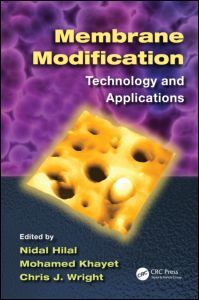Membrane Modification Technology and Applications
Coordonnateurs : Hilal Nidal, Khayet Mohamed, Wright Chris J.

Membrane Modification: Technology and Applications is written for engineers, scientists, graduate students, and researchers in the field of membrane science and technology, materials science, applied physics, chemistry, and environmental science. The book presents the complete range of membrane modification techniques used to increase efficiency of membrane processes. The book starts with an examination of the use of membrane modification to optimize the performance of membranes used in industry. It concludes by demonstrating how membrane modification can improve separation processes in industrial sectors that are recognized as global polluters of water sources.
Features
- Illustrates the use of Electrochemical Impedance Spectroscopy (EIS) in the characterization of commercial and novel membranes
- Overviews various surface modification techniques applied to enhance the bulk and surface properties of nanofiber membranes
- Covers the factors affecting membrane fouling and the use of nanoparticles in membrane modification processes
- Explores the use of plasma treatment for the modification of polymeric membranes
Written by professors, engineers, and researchers in the field, the book covers recent advances and comprehensively describes novel and most-used membrane characterization techniques. Modification of different materials and geometrics include flat-sheet, hollow-fiber, and nano-fiber membranes as well as different membrane processes such as reverse osmosis, membrane distillation, gas separation, pervaporation, and membrane fuel cells. Chapters contain tables, figures, photographs, and theoretical equations to aid with reader comprehension.
Membranes in Nuclear Science and Technology: Membrane Modification as a Tool for Performance Improvement. Use of Impedance Spectroscopy for Characterization of Modified Membranes. Reduction of Membrane Fouling by Polymer Surface Modification. Modifications of Polymeric Membranes by Incorporating Metal/Metal Oxide Nanoparticles. Development of Antifouling Properties and Performance of Nanofiltration Membranes by Interfacial Polymerization and Photografting Techniques. Integrating Hydrophobic Surface-Modifying Macromolecules into Hydrophilic Polymers to Produce Membranes for Membrane Distillation. Plasma Modification of Polymer Membranes. Surface Modification of Electrospun Nanofiber and Nanofibrous Membranes. Development of Membranes for Pervaporation by Membrane Surface Modification and Incorporation of Inorganic Particles. Tailor-Made Polymeric Membranes for Advanced Crystallization of Biomolecules. Chemical Cross-Linking Modifications of Polymeric Membranes for Gas Separation Applications. Development of Fuel Cell Polymer Electrolyte Membranes by Radiation-Induced Grafting with Electron-Beam Irradiation. Modification of Sulfonated Poly(Ether Ether Ketone) for DMFC Application. Nanofiltration Membrane in Textile Effluent Treatment. Future Prospects.
Mohamed Khayet is an affiliate of the Department of Applied Physics, University Complutense of Madrid, Spain.
Nidal Hilal is an affiliate of The Centre for Clean Water technologies, Swansea University, UK.
Chris Wright is an affiliate of The Center for Clean Water technologies, Swansea University, UK.
Date de parution : 06-2012
Ouvrage de 568 p.
15.6x23.4 cm
Thèmes de Membrane Modification :
Mots-clés :
UF Membrane; Composite Membrane; Membrane Fuel Cells; NF Membrane; Pervaporation; Membrane Fouling; Gas Separation; Plasma Treatment; Membrane Distillation; Proton Conductivity; Reverse Osmosis (RO); DMFC; Nano-fiber membranes; Fuel Cells; Membrane Surface; Nanocomposite Membranes; Methanol Permeability; Pe Membrane; Naon Membranes; Plasma Polymerization; Electrospun Nanobers; Equivalent Circuits; MD; Membrane Modication; Lm; Separation Factor; PS Membrane; Zeolite Membranes; UV Radiation Treatment; TiO2 Nanoparticles; Ceramic Membranes



